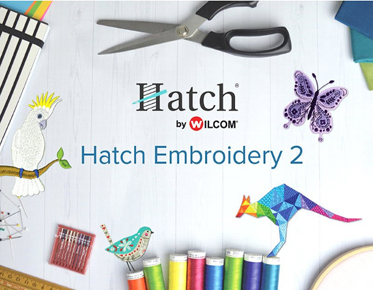Crafty Vibes: Master Creative Lettering with Hatch
Welcome to the world of creative lettering, where every stroke tells a story and every curve is a canvas for expression. Get ready to embark on a crafty journey filled with excitement and inspiration as we delve into the art of lettering with Hatch. Use these guidelines from Eagle Digitizing to find the best machine for your needs. For the best digitizing service, please feel free to contact us.
Unlocking the World of Creative Lettering
Behind every beautifully crafted letter lies a world of artistry waiting to be explored. In this section, we'll unravel the intricacies of creative lettering and introduce you to the versatile tools of Hatch, designed to unleash your inner lettering enthusiast.
Getting Started with Hatch
Let's kick off our lettering adventure by acquainting ourselves with the Hatch app and its myriad features. Follow along as we guide you through the simple steps of downloading and setting up Hatch, paving the way for endless lettering possibilities.
Exploring Lettering Styles
From timeless classics to contemporary trends, the world of lettering is vast and diverse. Join us as we dive into various lettering styles and techniques, drawing inspiration from a rich tapestry of artistic expressions.
Mastering Basic Lettering Techniques
Mastering basic lettering techniques requires patience, practice, and attention to detail. Here's a breakdown of essential steps to help you embark on your lettering journey:
Understand the Basics: Familiarize yourself with the terminology and basic principles of lettering. Learn about strokes, serif and sans-serif fonts, kerning, and spacing.
Acquire the Right Tools: Invest in quality tools such as pens, markers, pencils, and paper that are suitable for lettering. Experiment with different types and sizes to find what works best for you.
Practice Basic Strokes: Start by practicing basic strokes like upstrokes, downstrokes, and curves. Focus on achieving consistent thickness and smoothness in your lines.
Master Letterforms: Break down letters into basic shapes and strokes. Practice forming each letter individually, paying attention to proportions, spacing, and consistency.
Experiment with Styles: Explore different lettering styles such as script, serif, sans-serif, and decorative. Experiment with different techniques and find your own unique style.
Study Typography: Study typography to understand the principles behind letterforms and how they work together to create readable and visually appealing text.
Develop Muscle Memory: Repetition is key to mastering lettering. Practice regularly to develop muscle memory and improve your skills over time.
Seek Inspiration: Look for inspiration in books, websites, and social media platforms dedicated to lettering and typography. Analyze the work of other artists to learn new techniques and styles.
Receive Feedback: Share your work with others and seek constructive feedback. Join lettering communities or workshops where you can learn from experienced artists and receive guidance on how to improve.
Stay Patient and Persistent: Lettering takes time to master, so be patient with yourself and keep practicing. Celebrate your progress along the way and don't be afraid to make mistakes—they're essential for growth.
By following these steps and dedicating yourself to consistent practice, you'll gradually improve your lettering skills and develop the confidence to create captivating and expressive letterforms. Remember, mastering lettering is a journey, so enjoy the process and embrace the opportunity to unleash your creativity!
Playing with Flourishes and Embellishments
Elevate your lettering game by infusing it with decorative flourishes and embellishments. Learn how to add flair and personality to your designs as we explore the art of embellishment in lettering.
Mixing Colors and Textures
Mixing colors and textures in basic lettering techniques can add depth, interest, and personality to your artwork. Here's how you can experiment with these elements to create visually dynamic lettering pieces:
Understanding Color Theory:
Before diving into mixing colors,
it's essential to have a basic understanding of color theory. Familiarize
yourself with the color wheel, primary colors (red, blue, yellow), secondary
colors (orange, green, purple), and tertiary colors (mixtures of primary and
secondary colors).
Learn about color harmony and how
different color combinations evoke different emotions and moods. For example,
complementary colors (opposite on the color wheel) create contrast and
vibrancy, while analogous colors (next to each other on the color wheel) create
a sense of harmony.
Mixing Colors:
Experiment with mixing primary
colors to create a wide range of hues. For instance, mixing red and blue
creates purple, mixing blue and yellow creates green, and mixing red and yellow
creates orange.
Explore the use of different
mediums such as watercolors, acrylics, or markers to achieve various effects.
Each medium has its unique properties and techniques for mixing colors.
Gradually add white or black to
your color mixtures to create tints (lighter shades) and shades (darker tones)
of your chosen colors.
Choosing Textures:
Textures can add tactile and
visual interest to your lettering pieces. Experiment with different textures
such as smooth, rough, gritty, or metallic.
Consider incorporating textures
from various sources such as paper, fabric, wood, or digital textures created
using software like Photoshop or Procreate.
Think about how the texture
complements the message or theme of your lettering piece. For example, a rough,
distressed texture might convey a vintage or rugged aesthetic, while a smooth, glossy
texture might evoke a more modern and sleek vibe.
Combining Colors and Textures:
Experiment with layering colors
and textures to create depth and dimension in your lettering. For instance, you
could apply a base layer of color and then overlay it with a textured pattern
or gradient.
Consider the contrast between the
colors and textures you choose. A bold, vibrant color palette paired with
subtle, intricate textures can create a striking visual impact.
Pay attention to balance and
harmony in your compositions. Mix colors and textures in a way that enhances
the overall cohesiveness of your lettering piece rather than overwhelming the
viewer.
Practice and Experimentation:
Like any art form, mastering the
art of mixing colors and textures in lettering requires practice and
experimentation. Don't be afraid to play around with different color
combinations, textures, and techniques to discover what works best for you.
Keep a sketchbook or digital
journal where you can document your experiments and ideas. This will not only
help you track your progress but also serve as a valuable reference for future
projects.
By combining your knowledge of color theory with experimentation with various textures, you can create visually dynamic lettering pieces that captivate and inspire viewers. So, grab your brushes, pens, and paints, and let your creativity flow!
Personalizing Your Lettering Style
Personalizing your lettering style is a fantastic way to express your individuality and make your designs stand out. Here are some tips to help you infuse your lettering with personal touches and quirks:
Discover Your Style: Spend some time exploring different lettering styles, from elegant scripts to bold block letters. Experiment with different techniques and tools, such as brush pens, markers, or digital brushes. Pay attention to what feels most natural and resonates with you.
Draw Inspiration: Look for inspiration in unexpected places. Take a stroll through nature, browse through art galleries, or flip through magazines. Pay attention to the shapes, patterns, and textures that catch your eye, and consider how you can incorporate them into your lettering.
Add Flourishes and Embellishments: Experiment with adding flourishes, swirls, and other embellishments to your lettering. These decorative elements can help add personality and flair to your designs. Don't be afraid to let your imagination run wild and try out different combinations until you find what feels right.
Inject Your Personality: Think about what makes you unique and incorporate those elements into your lettering. Whether it's your sense of humor, love of nature, or passion for music, find ways to infuse your personality into your designs. This could be through the choice of words, the style of lettering, or the overall composition.
Play with Color and Texture: Experiment with different colors and textures to add depth and dimension to your lettering. Consider using watercolors, gouache, or digital brushes to create interesting effects. Don't be afraid to mix and match different hues and tones to create a vibrant and dynamic composition.
Practice Consistently: Like any skill, improving your lettering takes time and practice. Set aside dedicated time each day to practice your lettering, experiment with new techniques, and refine your style. Don't be discouraged by mistakes or imperfections – embrace them as opportunities to learn and grow.
Seek Feedback: Share your work with others and seek feedback from fellow lettering enthusiasts or mentors. This can provide valuable insights and perspectives that can help you refine your style and identify areas for improvement.
Stay True to Yourself: Ultimately, the most important thing is to stay true to yourself and your unique vision. Don't feel pressured to conform to trends or follow the latest fads – embrace what makes you different and let your personality shine through in your lettering.
Typography and Composition Essentials
Typography is the backbone of lettering, guiding us in crafting harmonious compositions that captivate the eye. Gain insights into typography fundamentals and learn the art of effective composition in lettering designs.
Sustainability and Lettering
As stewards of creativity, it's essential to incorporate eco-friendly practices into our lettering projects. Learn how to reduce waste and choose sustainable materials, ensuring that your craft leaves a positive impact on the planet.
Conclusion
As we conclude our journey of
mastering creative lettering with Hatch, take a moment to reflect on the beauty
and joy found in every stroke of the pen. Let this journey inspire you to
continue exploring your creativity and lettering skills, with Hatch as your
trusted companion along the way.



